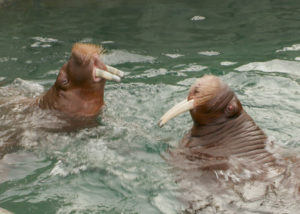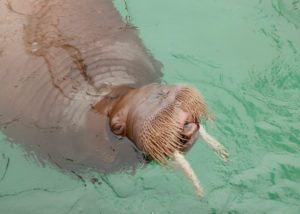They were rescued as orphans in the same week. They spent the next three months of their lives together, snuggling with keepers and each other. And now, after seven years, they’ll be together again.

Young male walruses Mitik (pronounced Mitt-ick) and Pakak (Puck-uck, or Puck for short) have arrived at Point Defiance Zoo & Aquarium to live in the Rocky Shores habitat – and they are clearly enjoying every minute together.
“They vocalize back and forth to each other, and follow each other around the pool,” said Amanda Shaffer, senior staff biologist at Rocky Shores, immediately after Mitik and Pakak arrived yesterday. “They’re obviously really comfortable with each other, and their new home. It will be interesting to watch these young walruses grow up.”
“They’re in good health,” reported Head Veterinarian Dr. Karen Wolf, who gave the pair a visual exam on their arrival. “They’re very inquisitive, exploring their new environment and getting to know each other.”
As they adjust to their surroundings, the walruses will have access to both public and behind-the-scenes areas. If visitors cannot see them, they’ll probably hear them making high-pitched whistles, bubbling, blowing and other noises.
How to tell them apart? Mitik has shorter, fatter tusks. He doesn’t whistle at this time of year. Patak has longer, thinner tusks, and more protruding eyes, which can look a little red from the blood vessels keeping him warm. He whistles all year round.
The other thing visitors will notice immediately are the metal caps on their tusks, which are temporarily glued on to protect the tusks as the walruses grow – a bit like a human tooth crown.
For two young walruses, Mitik and Pakak have quite a story – and media fame to boot.
Both were rescued as calves by local fishermen off the coast near Barrow, Alaska, in July 2012. They were about a month old and in trouble: Pakak got wound up in some fishing nets, while Mitik tried to climb into a boat, according to a spokesperson at the Alaska SeaLife Center in Seward.
Badly dehydrated and in poor health, they were cared for at the SeaLife Center, a job that included a lot of physical togetherness (walrus are highly social animals, sleeping in piles) as well as medical rehabilitation and round-the-clock bottle feeding.

In October 2012 they were strong enough to find homes at other zoos. Pakak, whose name means ‘one that gets into everything’ in Inupiaq, went to the Indianapolis Zoo, while Mitik, named after the daughter of the fisherman who found him, went first to the New York Aquarium and, eventually, SeaWorld San Diego. The walruses were featured in stories and videos from the New York Times to Today and Grist.
And now, they’re coming to live at Point Defiance Zoo. It’s all part of a nationwide walrus plan that saw Basilla and Kulusiq, the zoo’s two female walruses, move to San Diego last month to be with breeding male Dozer.
“There are only 14 walruses in human care in the United States, and only a handful of zoos who can care for them,” explained Malia Somerville, curator of marine mammals and birds. “Many are rescued animals; all are ambassadors for this incredible species facing an uncertain future due to climate change. Breeding is a part of that care.”
In the wild, walruses live in huge colonies or ‘leks,’ especially to breed. So the Walrus Conservation Consortium of zoos and aquariums is working to create mini-colonies for breeding-age walruses. Other zoos like Tacoma’s will give homes to younger animals like Mitik and Pakak.
The two walruses flew in separately earlier this week, each accompanied by a keeper and veterinarian. They traveled well, said Somerville, and settled into the pools at Rocky Shores with ease, swimming, diving and playfully rolling over each other in the water.
Pakak has “a great energy,” says staff biologist Sheriden Ploof. “He is very smart, eager to learn new behaviors and seems to really enjoy interacting with keepers.”
Mitik is also very interested in people, says Shaffer. “We’re learning a lot about them.”
As young males, the two still have some growing to do. Mitik weighs around 1,700 pounds and Pakak 1,560 – a grown male can weigh up to 5,000 pounds.
“We don’t know if they recognize each other after so long, but we do know that other marine mammals do, such as dolphins and sea lions,” Somerville said. “We’re really happy to care for Mitik and Pakak here at Point Defiance Zoo, where they can connect our guests with this amazing species and be inspired to help protect them in the wild.”
Pacific walruses are a threatened species, found in the Bering and Chukchi seas. They feed on clams from the ocean floor and haul out on polar ice to sleep and breed. Hunted by orcas, polar bears and humans, their main threat is actually climate change: As Arctic ice melts they lose their haul-out sites and are forced to forage in shallow water, where the food quickly runs out.
Point Defiance Zoo is a leader in walrus research and conservation, supporting projects through the Dr. Holly Reed Conservation Fund. But everyone can help slow climate change to protect walruses and other species by not idling cars, shopping local, turning down the thermostat and many other actions.
Learn more here: About Pacific walruses, and climate change.